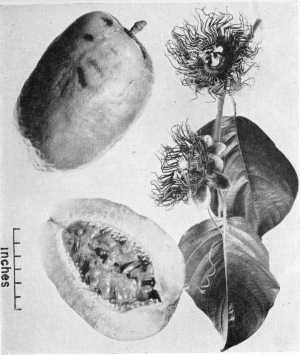Giant Granadilla
Scientific Name: Passiflora quadrangularis L.
Synonym: Passiflora macrocarpa
Family: Passifloraceae
USDA: 10-12
Frost Tolerance: Tropical plant, tender in Phoenix. Needs a warm location, probably along a south wall, even then the foliage is often damaged or killed in winter
Heat Tolerance: Afternoon shade in Phoenix
Sun Exposure: Full sun
Origin: Tropical Americas, exact origin unkown, since it is now widely cultivated
Growth Habits: Vigorous vine, up to 50 feet long in one growing season (15 m)
Watering Needs: Regular water, good drainage. Not very tolerant of flooding
Propagation: Seeds, cuttings
The Giant Granadilla forms a larger leaf and is a more vigorous grower than the yellow passion fruit. The cordate leaves are 5 to 7 inches long (12-17 cm) and arranged alternately on the stem. This plant derives its botanical name from the fact that the stems are quad rangular in cross section.
Blooming Habits:
The flowers are 5 inches in diameter but hang down so that the red petals and the purple and white rays are not as showy as those of some other Passiflora species. The flowers usually need to be hand-pollinated to effect fertilization. It should be done in the late morning, no later than 4 to 6 hours after the flowers open.
Fruiting Habits:
Fruit of the giant granadilla reach a length of up to 12 inches and turn yellow when mature. The pulp around the seeds is used to flavor ice cream and to make a cooling drink. In addition, the flesh of this fruit is edible. The green fruit is boiled and eaten as a vegetable. The fully ripe flesh is eaten alone or in combination with such fruits as papaya and pineapple. The ripening fruits should be protected with wirecloth enclosures as they are a favorite food of rats, birds, and bats.
Culture:
The griant granadilla grows well over a variety of soil types, but might suffer micro-nutrient deficiencies on highly alkaline soils. It benefits from annual pruning to control its size and to produce young juvenile wood which produces more flowers and potential fruit. It should not be allowed to grow on any tree since it will compete agressively for space in the sun, and it might damage or kill its support.
The granadilla passion vines has few pest problems.
Propagation:
As with the yellow passion fruit, the giant granadilla usually is propagated by seeds that germinate in 2-3 weeks. It can be propagated by softwood cuttings under mist, or semi-hardwood in moist sand.
Desert-Tropicals is dedicated to provide gardening advice, gardening ideas, and information about flower of all kind for landscape and collections.We try to check carefully the identification of the plants on the illustrations as well as the other information from the page, but occasionally errors do occur. if you notice anything that needs to be changed please contact us.Thanks.
© 1998-2020 Philippe Faucon, All Rights Reserved.
